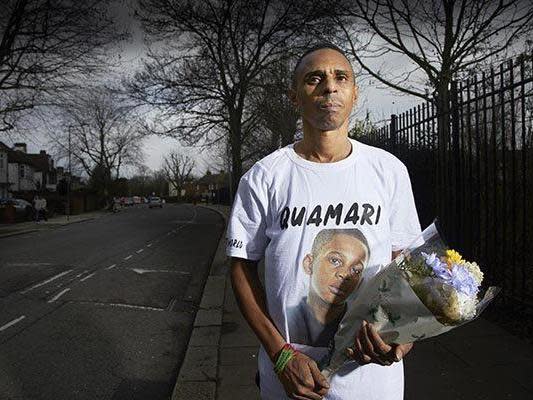A Year of British Murder review: An ambitious profile that goes ‘beyond the statistics’
A Year of British Murder (Channel 4) is an ambitious affair, and one that fulfilled its exacting remit of drawing an accurate profile of British murder, and to “go beyond the statistics”.
Harrowing as all of the chosen cases are, you feel like you still want to learn more about the families, friends and the victims themselves – not in a prurient, voyeuristic way, but just from a deep sense of empathy. The programme-makers must have done much to win the confidence of so many friends and families, as they went through unspeakable personal pain; but they repay that confidence with an understated and powerful film. There are silences, tears, seasonal scenes that place a gentle chronology on the cases – it’s a fine piece of documentary-making.
One of the most upsetting of the stories is that of Razvan Sirbu. Here was a young Romanian lad who came to England with his mother “with a lot of dreams”. He drifted into drink and drugs, rowed with his hard-working mum, and ended up sleeping in a tent in woodland, outside Maidstone. There he had the misfortune to be set upon randomly by two thugs. He was subjected to a sustained and unprovoked assault, including with a meat cleaver. They did it for kicks. He was 21.
Witnessing his mum Marinella Gafita being informed in cold, exact legalistic terms by the Kent police, through a translator, about happened to her boy, and seeing her sign a receipt for two cardboard boxes of his possessions, blood-stained clothes included, is just heart-breaking to watch. The detective was doing his best, but it makes one wonder whether we are still doing our best for victims. She wanted to place a cross at the place Razvan ended his life but was told by some busy-bodies that it was “inappropriate” to do so in a “conservation area”. Callous. Her life “has stopped”; her son’s killers got life but she wasn’t able to have her last, modest, wish.
Razvan’s was one of the 17 per cent of murders to have no known motive – no benefit at all to the killers, and thus the most inexplicable, and an unusually hard-to-accept form of homicide.
Taking this case and others in a sample of the 768 murders committed in the UK during 2017, the programme sets the hard data calmly against the human loss and trauma that lies beyond them. There are babies shaken to death; boyfriends stabbing girlfriends with almost immediate remorse and confession; street stabbings; and a victim of the Westminster Bridge terrorist. There is no great mystery to any of these deaths, and no great need to devote as much time as to others. The time taken to tell their stories varies, but only insofar as it concerns what had happened. The changing pace is appropriate, and not judgemental; the respect is equal.
Britain’s homicide rate has generally been stable over time, as has the broad pattern of motive, means and opportunity. Some of the facts of violent death are depressingly familiar, such as that 78 per cent of female victims are killed in their own homes – often by abusive partners.
Some are more unexpected. Thus, for example, contrary to the notion that Britain is being overwhelmed by a wave of deadly muggings, only 6 per cent of murders are for theft or gain. When they are, they have an especially squalid facet. Such as when a Shrewsbury cafe owner, Satnam Singh Blugher, took pity on a former employee, gave him his job back and was shortly after killed in cold blood for £47,000 in cash, plus some gold jewellery. His killer even went through his pockets for loose change. He made off with the haul in a huge suitcase, ambling down the street on CCTV. He got 28 years for a crime he was never going to get away with.
Given the headlines about “wild west Britain” and the “epidemic” of knife crime, you’d never think that only 8 per cent of homicide victims are under 16, and only 3 per cent of victims are below that age. Quamari Serunkuma-Barnes, stabbed three times outside the Capital City Academy in Willesden, west London, by another 15-year-old boy, was an example that shed some light on a common crime – carrying a blade – but with an uncommonly fatal outcome. He got 14 years at the Old Bailey.
Quamari’s bereaved parents say that campaigning for an end to gun and knife crime is something has helped them to deal with the loss, something that has been pressed upon them. Like the Lawrences before them, they have been transformed by tragic events into more public figures. They are divided as to whether to accept the condolences and apologies of the murderer’s mother.
Indeed, what comes across strongly is a general lingering sense of “injustice” felt by the families – a lack of closure. You know what they mean – but it’s the wrong word. Almost all of the cases were rapidly solved, the perpetrators brought to trial and, on the whole, properly sentenced. “Justice” is done, in that sense.
What the families and friends mean by “justice” is retribution, an old-fashioned world that carries its own moral imperative. Without any need to embellish or sensationalise, the film also makes the viewer side with the families, and angrily. These few cases are enough even to make the most liberal of consciences toy with the noose.

 Yahoo News
Yahoo News 

